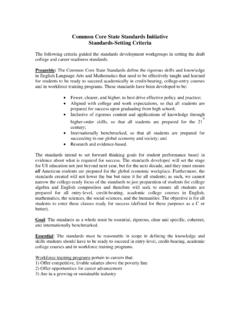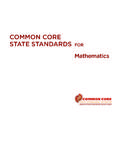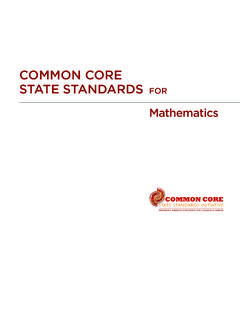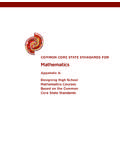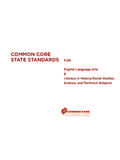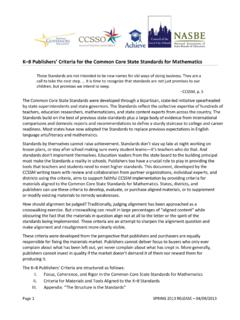Transcription of Frequently Asked Questions - Common Core State …
1 Frequently Asked Questions The following provides answers to some of the Frequently Asked Questions about the Common Core State standards , from how they were developed to what they mean for states and local communities. Overview What are educational standards ? Educational standards are the learning goals for what students should know and be able to do at each grade level. Educational standards help teachers ensure their students have the skills and knowledge they need to be successful, while also helping parents understand what is expected of their children. What is the Common Core? State education chiefs and governors in 48 states came together to develop the Common Core, a set of clear college - and career -ready standards for kindergarten through 12th grade in English language arts/literacy and mathematics. Today, 43 states have voluntarily adopted and are working to implement the standards , which are designed to ensure that students graduating from high school are prepared to take credit bearing introductory courses in two- or four-year college programs or enter the workforce.
2 Who led the development of the Common Core State standards ? The nation's governors and education commissioners, through their representative organizations, the National Governors Association Center for Best Practices (NGA) and the Council of Chief State School Officers (CCSSO), led the development of the Common Core State standards and continue to lead the initiative. Teachers, parents, school administrators, and experts from across the country, together with State leaders, provided input into the development of the standards . The actual implementation of the Common Core, including how the standards are taught, the curriculum developed, and the materials used to support teachers as they help students reach the standards , is led entirely at the State and local levels. Were teachers involved in the creation of the standards ? Yes, teachers have been a critical voice in the development of the standards . The Common Core drafting process relied on teachers and standards experts from across the country.
3 The National Education Association (NEA), American Federation of Teachers (AFT), National Council of Teachers of Mathematics (NCTM), and National Council of Teachers of English (NCTE), among other organizations, were instrumental in bringing together teachers to provide specific, constructive feedback on the standards . Why are the Common Core State standards important? High standards that are consistent across states provide teachers, parents, and students with a set of clear expectations to ensure that all students have the skills and knowledge necessary to succeed in college , career , and life upon graduation from high school, regardless of where they live. These standards are aligned to the expectations of colleges, workforce training programs, and employers. The standards promote equity by ensuring all students are well prepared to collaborate and compete with their peers in the United states and abroad. Unlike previous State standards , which varied widely from State to State , the Common Core enables collaboration among states on a range of tools and policies, including the: Frequently Asked Questions Page 1.
4 Development of textbooks, digital media, and other teaching materials Development and implementation of Common comprehensive assessment systems that replace existing State testing systems in order to measure student performance annually and provide teachers with specific feedback to help ensure students are on the path to success Development of tools and other supports to help educators and schools ensure all students are able to learn the new standards Who was involved in the development of the Common Core State standards ? states across the country collaborated with teachers, researchers, and leading experts to design and develop the Common Core State standards . Each State independently made the decision to adopt the Common Core. Local teachers, principals, and superintendents lead the implementation of the Common Core in their states . The federal government was not involved in the development of the standards . What guidance do the Common Core State standards provide to teachers?
5 The Common Core State standards are a clear set of shared goals and expectations for the knowledge and skills students need in English language arts and mathematics at each grade level so they can be prepared to succeed in college , career , and life. The standards establish what students need to learn, but they do not dictate how teachers should teach. Teachers will devise their own lesson plans and curriculum, and tailor their instruction to the individual needs of the students in their classrooms. How do the Common Core State standards compare to previous State education standards ? The Common Core was developed by building on the best State standards in the United states ;. examining the expectations of other high-performing countries around the world; and carefully studying the research and literature available on what students need to know and be able to do to be successful in college , career , and life. No State was Asked to lower their expectations for students in adopting the Common Core.
6 The evidence-based standards were developed in consultation with teachers and parents from across the country, so they are also realistic and practical for the classroom. How much will it cost states to implement the Common Core State standards ? Costs for implementing the standards will vary from State to State and territory. While states already spend significant amounts of money on professional development, curriculum materials, and assessments, there will be some additional costs associated with the Common Core, such as training teachers to teach the standards , developing and purchasing new materials, and other aspects of implementation. However, there are also opportunities for states to save considerable resources by using technology, open-source materials, and taking advantage of cross- State opportunities that come from sharing consistent standards . What is the appropriate way to cite the Common Core State standards ? Authors: National Governors Association Center for Best Practices, Council of Chief State School Officers Title: Common Core State standards (insert specific content area if you are using only one).
7 Publisher: National Governors Association Center for Best Practices, Council of Chief State School Officers, Washington Copyright Date: 2010. For more information, please visit our pages for Developers & Publishers, Terms of Use, and Public License. Frequently Asked Questions Page 2. Process What makes this process different from other efforts to create Common standards ? From the very beginning, the process of developing the Common Core has been bipartisan and State led. It also has support from educators, policymakers, and business leaders across the country, including CCSSO, the NGA Center, Achieve, Inc., ACT, the college Board, the National Association of State Boards of Education, the Alliance for Excellent Education, the Hunt Institute, the National Parent Teacher Association, the State Higher Education Executive Officers, the American Association of School Administrators, the Chamber of Commerce, and the Business Roundtable. What evidence and criteria were used to develop the standards ?
8 The standards made careful use of a large and growing body of evidence, including: Scholarly research Surveys on the skills required of students entering college and workforce training programs Assessment data identifying college - and career -ready performance Comparisons to standards from high-performing states and nations National Assessment of Educational Progress (NAEP) frameworks in reading and writing for English language arts Findings from Trends in International Mathematics and Science (TIMSS) and other studies, which conclude that the traditional mathematics curriculum must become substantially more coherent and focused in order to improve student achievement The following criteria guided the development of the standards : Alignment with expectations for college and career success Clarity Consistency across all states Inclusion of content and the application of knowledge through high-order skills Improvement upon current State standards and standards of top-performing nations Reality-based for effective use in the classroom Evidence- and research-based What role did international benchmarking play in the development of the standards ?
9 International benchmarking refers to analyzing high-performing education systems and identifying ways to improve our own system based on those findings. One of the ways to analyze education systems is to compare international assessments, particularly the Programme for International Student Assessment (PISA) and Trends in International Mathematics and Science Study (TIMSS). Prior to the development of the Common Core State standards , research revealed striking similarities among the standards in top- performing nations, along with stark differences between those world-class expectations and the standards adopted by most states . As a result, standards from top-performing countries were consulted during the development of the Common Core State standards . The college - and career -ready standards appendix lists the evidence consulted. What grade levels are included in the Common Core State standards ? The English language arts and math standards are for grades K-12. Research from the early childhood and higher education communities also informed the development of the standards .
10 Frequently Asked Questions Page 3. What does this work mean for students with disabilities and English language learners? The Common Core State standards give states the opportunity to share experiences and best practices, which can lead to an improved ability to serve young people with disabilities and English language learners. Additionally, the standards include information on application for these groups of students. Why are the Common Core State standards only for English language arts and math? English language arts and math were the subjects chosen for the Common Core State standards because they are areas upon which students build skill sets that are used in other subjects. Students must learn to read, write, speak, listen, and use language effectively in a variety of content areas, so the standards specify the literacy skills and understandings required for college and career readiness in multiple disciplines. It is important to note that the literacy standards in history/social studies, science, and technical subjects for grades 6 12 are meant to supplement content standards in those areas, not replace them.
